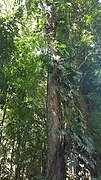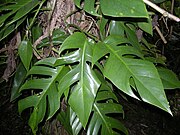
Epipremnum pinnatum

| Centipede tongavine | |
|---|---|

| |
| Wild Epipremnum pinnatum in the Philippines showing both pinnately-divided mature leaves and entire young leaves | |
| Scientific classification | |
| Kingdom: | Plantae |
| Clade: | Tracheophytes |
| Clade: | Angiosperms |
| Clade: | Monocots |
| Order: | Alismatales |
| Family: | Araceae |
| Genus: | Epipremnum |
| Species: | E. pinnatum
|
| Binomial name | |
| Epipremnum pinnatum | |
| Synonyms[1] | |
|
Numerous
| |
Epipremnum pinnatum is a species of flowering plant in the family Araceae. It has many common names, including centipede tongavine, taro vine, silver vine and dragon-tail plant. In the Philippines, it is known in Tagalog as tibatib.

Epipremnum pinnatum starts life on the ground and climbs up trees in its natural forest environment, transitioning to an epiphytic lifestyle over time. It exhibits foliage dimorphism, where juvenile leaves look different from mature leaves of the same plant. [2]

Distribution
The plant has a broad native Old World distribution. Native range extends from Northern Australia through Malaysia and Indochina into southern China, Taiwan, Japan, and as far as Melanesia[3][4]. The species has also become naturalised in the West Indies.[4]

Cultivation
The plant has been kept as a houseplant or garden plant for ornamental purposes. Its leaves possess an aesthetic value, and the plant can be hardy in most indoor conditions. In a flower pot, or at a smaller size, its growth is similar to many vining plants, following a drooping, creeping pattern. Aerial roots will dot the stem. Instead of letting the plant hang, some gardeners prefer to add a small lattice or climbing pole for the plant, which would allow it to climb into a more visually interesting shape.

In a pot, the plant needs water retaining, porous soil. Many commercially available houseplant or tropical garden soil mixes will suffice. The plant is not entirely drought resistant, and needs the soil it's rooted in to be watered weekly, or more frequently in a bigger pot. So long as the soil is allowed to partially or fully dry a couple inches down between waterings. It helps to provide good drainage to the pot, as standing water can damage the plant's roots.

Gallery
-
Illustration, Plantae Asiaticae Rariores, vol. 2: t. 192 (1831)
-
Wild Epipremnum pinnatum in the Philippines showing its liana habit
-
various forms of leaves in different sizes
-
Aerial roots
References
- ^ Epipremnum pinnatum (L.) Engl.. In: The Plant List (2013). Version 1.1. Published on the Internet; http://www.theplantlist.org/ [2015-2-28].
- ^ "NParks | Epipremnum pinnatum". www.nparks.gov.sg. Retrieved 2024-04-29.
- ^ Epipremnum pinnatum. In: Govaerts, R. (2015). World Checklist of Araceae. Facilitated by the Royal Botanic Gardens, Kew. Published on the Internet; http://apps.kew.org/wcsp/ Retrieved 2015-2-28.
- ^ a b "Epipremnum pinnatum". Germplasm Resources Information Network. Agricultural Research Service, United States Department of Agriculture. Retrieved 28 February 2015.
External links
 Data related to Epipremnum pinnatum at Wikispecies
Data related to Epipremnum pinnatum at Wikispecies Media related to Epipremnum pinnatum at Wikimedia Commons
Media related to Epipremnum pinnatum at Wikimedia Commons
See what we do next...
OR
By submitting your email or phone number, you're giving mschf permission to send you email and/or recurring marketing texts. Data rates may apply. Text stop to cancel, help for help.
Success: You're subscribed now !





